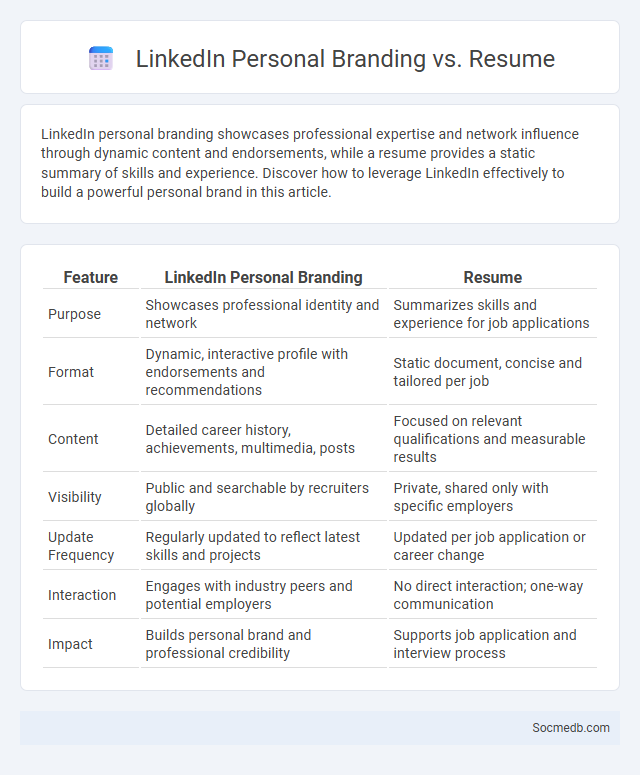
Photo illustration: LinkedIn Personal Branding vs Resume
LinkedIn personal branding showcases professional expertise and network influence through dynamic content and endorsements, while a resume provides a static summary of skills and experience. Discover how to leverage LinkedIn effectively to build a powerful personal brand in this article.
Table of Comparison
| Feature | LinkedIn Personal Branding | Resume |
|---|---|---|
| Purpose | Showcases professional identity and network | Summarizes skills and experience for job applications |
| Format | Dynamic, interactive profile with endorsements and recommendations | Static document, concise and tailored per job |
| Content | Detailed career history, achievements, multimedia, posts | Focused on relevant qualifications and measurable results |
| Visibility | Public and searchable by recruiters globally | Private, shared only with specific employers |
| Update Frequency | Regularly updated to reflect latest skills and projects | Updated per job application or career change |
| Interaction | Engages with industry peers and potential employers | No direct interaction; one-way communication |
| Impact | Builds personal brand and professional credibility | Supports job application and interview process |
Understanding LinkedIn Personal Branding
LinkedIn personal branding leverages a professional profile to showcase expertise, achievements, and industry influence, enhancing credibility and networking opportunities. Optimizing LinkedIn profiles with relevant keywords, a professional photo, and detailed experience boosts visibility in search results. Consistent content sharing and engagement on LinkedIn establish thought leadership and strengthen career prospects.
The Power of a Traditional Resume
A traditional resume remains a powerful tool for showcasing Your professional experience and skills in a clear, concise format preferred by many employers over social media profiles. Despite the rise of platforms like LinkedIn, a well-crafted resume provides a focused narrative of Your career achievements, making it easier to pass applicant tracking systems (ATS). Leveraging the strengths of a traditional resume alongside social media can maximize Your visibility and credibility in the job market.
Defining Personal Branding Beyond LinkedIn
Personal branding extends beyond LinkedIn by encompassing a strategic presence on platforms like Instagram, Twitter, and TikTok, where individuals showcase authentic content and engage diverse audiences. Developing a cohesive personal brand involves consistent messaging, visual identity, and value-driven storytelling across multiple social channels. Leveraging analytics tools to track engagement and refine content strategies enhances brand visibility and professional influence beyond professional networking sites.
Key Differences: LinkedIn Personal Branding vs Resume
LinkedIn personal branding emphasizes showcasing Your professional identity through a dynamic mix of endorsements, multimedia content, and network interactions, while a resume primarily focuses on concise, chronological work experience and achievements. LinkedIn allows for ongoing engagement and personal storytelling, making it essential for building relationships and demonstrating expertise in real-time. In contrast, resumes are static documents tailored for targeted job applications, highlighting skills and qualifications in a more formal and summarized format.
Why Personal Branding Matters in Your Career
Personal branding plays a crucial role in career advancement by establishing a distinct professional identity that highlights unique skills and expertise. Effective personal branding on social media platforms like LinkedIn, Twitter, and Instagram increases visibility to recruiters and industry leaders, fostering opportunities for networking and job offers. Consistent, authentic personal branding builds trust and credibility, making professionals more competitive in crowded job markets.
LinkedIn Profile Optimization for Personal Branding
Optimizing a LinkedIn profile enhances personal branding by strategically incorporating relevant keywords, showcasing professional achievements, and maintaining a consistent, industry-specific narrative. A well-crafted headline, detailed experience sections, and endorsements from colleagues strengthen credibility and attract potential recruiters or clients. Regular updates, engaging content sharing, and participation in LinkedIn groups amplify visibility and networking opportunities within targeted professional communities.
Resume Strategies for Modern Job Seekers
Optimizing your social media presence is crucial for modern job seekers aiming to enhance their resume visibility. Integrate relevant keywords and showcase professional achievements across LinkedIn, Twitter, and industry-specific platforms to attract recruiters. Tailoring your online profiles to align with job postings increases your chances of standing out in a competitive job market.
Integrating Offline and Online Personal Branding
Integrating offline and online personal branding creates a cohesive and authentic presence that strengthens your reputation across social media platforms and real-world interactions. Consistent messaging, visual identity, and engagement strategies allow your audience to recognize and trust your brand both digitally and in person. Optimizing your social media profiles to reflect offline experiences and values maximizes your influence and professional opportunities.
Common Mistakes in LinkedIn and Resume Branding
Many professionals overlook the importance of consistency between their LinkedIn profiles and resumes, leading to mixed messaging that confuses recruiters. Using generic headlines or vague job descriptions on LinkedIn fails to highlight specific skills and measurable achievements, diminishing personal branding impact. Neglecting keywords relevant to industry standards and target roles reduces visibility in applicant tracking systems and search results, hindering career advancement opportunities.
Choosing the Right Approach for Your Professional Goals
Selecting the right social media platform tailored to your professional goals enhances visibility and networking opportunities within your industry. Analyzing audience demographics, content format preferences, and engagement rates enables you to craft targeted strategies that maximize impact. Aligning your content with the values and expectations of your chosen platform ensures that your professional brand resonates authentically with potential clients and collaborators.
 socmedb.com
socmedb.com